Coordinators:
Kim Seog-min (South Korea)
Hideo Shimura (Japan)
Peter Adriaens (Belgium)
Mars Muusse (Netherlands)
slaty rings
slaty PDFs
slaty 1cy August
slaty 1cy September
slaty 1cy October
slaty 1cy November
slaty 1cy December
slaty 2cy January
slaty 2cy February
slaty 2cy March
slaty 2cy April
slaty 2cy May
slaty 2cy June
slaty 2cy July
slaty 2cy August
slaty 2cy September
slaty 2cy October
slaty 2cy November
slaty 2cy December
slaty 3cy January
slaty 3cy February
slaty 3cy March
slaty 3cy April
slaty 3cy May
slaty 3cy June
slaty 3cy July
slaty 3cy August
slaty 3cy September
slaty 3cy October
slaty 3cy November
slaty 3cy December
slaty sub-ad January
slaty sub-ad February
slaty sub-ad March
slaty sub-ad April
slaty sub-ad May
slaty sub-ad June
slaty sub-ad July
slaty sub-ad August
slaty sub-ad September
slaty sub-ad October
slaty sub-ad November
slaty sub-ad December
slaty ad January
slaty ad February
slaty ad March
slaty ad April
slaty ad May
slaty ad June
slaty ad July
slaty ad August
slaty ad September
slaty ad October
slaty ad November
slaty ad December
|
Slaty-backed Gull (schistisagus) adult March
Identification of Slaty-backed Gull (schistisagus)
PART 1: description of adults
PART 2: description of 1st cycles
PART 3: description of 2nd cycles (this page)
PART 4:
Text from "Gulls of Europe, Asia and North America", by Malling Olsen, K. & Larsson, H. (Christopher Helm, London, 2004).
"we" in the text below refers to the original authors. If any errors occur in this text, please let me know and mail to marsmuusseatgmaildotcom.
PART 3: description of 2nd cycle birds
Second-winter varies. Most have whitish head and body with strong dark spots or streaks (mirroring elongated dark eye-mask surrounding pale eyes of adult) and lower belly normally pale. Outer wing and tail similar to first-winter, but blacker, the primaries being round-tipped with narrow white edges. Outer webs of outer primaries darker, but inner primaries paler, thus forming more contrasting pale window than in first-years. Saddle with mixture (sometimes predominance) of slaty, pale-edged feathers and browner ones, patterned as in first-winter. Saddle often contrasts well with paler, often whitish wing-coverts, which may be intermixed with slaty feathers. Greater coverts sometimes mud-brown, appearing uniform or with fine whitish vermiculations. Secondaries black, and may appear darkest part of wing. White rump contrasts well with dark tail. Underwing shows varying brown edges to especially lesser and median coverts, but often whitish greater coverts and axillaries, creating whitish midwing-panel, which again contrasts with silvery-based flight feather bases to create three-coloured underwing. Bill pale with variable black bar.
Second-summer acquires dark slate saddle (often only partial) in strong contrast to mainly whitish coverts and inner primaries, which again contrasts with dark, pale-streaked and -spotted outer wing. Darkest of upperparts are inner secondaries followed by new inner primaries. Tertials, tail and outer primaries faded brownish. Head and underbody mainly white; hindneck sometimes dark-spotted. Bill yellow to flesh with variable black markings. Eye pale.
 |
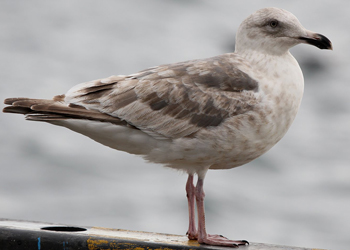 |
| Slaty-backed Gull (schistisagus) 2nd cycle (2CY), December 26 2013, Hokkaido, Japan (Ian Davies).
Upperpart grey tone shining through as the new feathers grow in. Pale iris in this bird, much dark in tail. Note overall very simple pattern on wing-coverts and tertials, lacking any notching (no post-stamp edges). Strong pink, short-looking legs. |
Slaty-backed Gull schistisagus 2nd cycle (3CY), January 02 2010, Choshi, Japan (Chris Gibbins). Bird in paler end of the spectrum. Some scapulars and MC show the adult upperpart grey tone, which is as in Lesser Black-backed Gull. Tail largely dark and pattern on wing-coverts very simple, plain pale brown with dark shaft or dark triangle centre. Note strong bill and very central placed eye in the head. Pale iris and faded brown primaries. |
 |
 |
| Slaty-backed Gull (schistisagus) 2nd cycle (3CY), March 29 2008, Nemuro, Hokkaido, Japan. Picture: Shiroto.Pale iris. Some scapulars show the adult upperpart grey tone. Tail largely dark and pattern on wing-coverts very simple, plain pale brown with dark shaft or dark triangle centre. Pink legs. |
Slaty-backed Gull (schistisagus) 2nd cycle (2CY), December 25 2013, Hokkaido, Japan (Ian Davies). Upperpart grey tone shining through as the new feathers grow in. Dark iris in this bird, much dark in tail. Note overall very simple pattern on wing-coverts and tertials. |
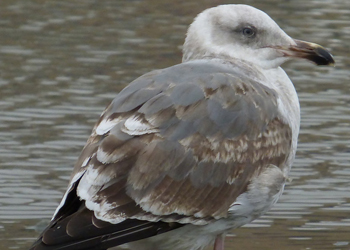 |
 |
| Western Gull (occidentalis) 2nd cycle (2CY), December 17 2015, Eureka waterfront, CA (E Fox). How to tell the hybrid combo "Olympic Gull" (occidentalis x glaucescens) in 2nd cycle and 3rd cycle from immature pure Westerns? It can be struggling with distinguishing sub-adult Westerns from GWGU crosses. 2nd winter WEGU should have head streaking, but how much (if any) is too much for a pure Western? This here pictures gull seems otherwise good for WEGU. |
Western Gull (occidentalis) 2nd cycle (2CY), December 17 2015, Eureka waterfront, CA (E Fox). How to tell the hybrid combo "Olympic Gull" (occidentalis x glaucescens) in 2nd cycle and 3rd cycle from immature pure Westerns? It can be struggling with distinguishing sub-adult Westerns from GWGU crosses. 2nd winter WEGU should have head streaking, but how much (if any) is too much for a pure Western? This here pictures gull seems otherwise good for WEGU. |
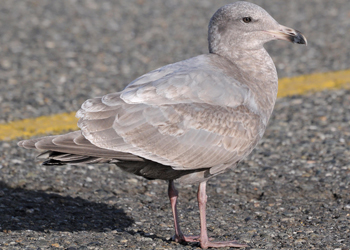 |
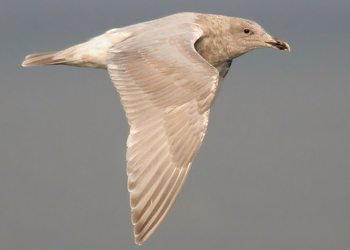 |
| hybrid Glaucous-winged x Western Gull (glaucescens x occidentalis) 2nd cycle (3CY), January 31 2011; Mukilteo, Washington, USA (Steve Mlodinow).
Wingtips and back too dark for pure GWGU. Wingtips and back not dark enough for WEGU. Bill stout, primaries short, unlike GWxHEGU, which would also typically have paler mantle. |
hybrid Glaucous-winged x Western Gull (glaucescens x occidentalis) 2nd cycle (2CY), October 28 2011, Elwha River Mouth, Washington, USA (Steve Mlodinow). Dark on primaries more extensive than pure GW Gull and back a bit darker than one would expect for GW Gull. |
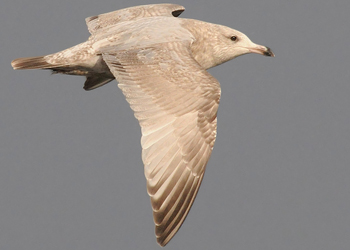 |
 |
| hybrid Glaucous-winged x Herring Gull (glaucescens x smithsonianus) 2nd cycle (2CY), October 28 2011, Elwha River Mouth, Washington, USA (Steve Mlodinow). Broad arm and inner primaries much too pale for 2nd gen inner primaries of Slaty-backed Gull, and pale grey upperparts indicated by recently replaced scaps leave no room for confusion with Slaty-backed. |
hybrid Glaucous-winged x Herring Gull (glaucescens x smithsonianus) 2nd cycle (2CY), October 28 2011, Elwha River Mouth, Washington, USA (Steve Mlodinow). Broad arm and inner primaries much too pale for 2nd gen inner primaries of Slaty-backed Gull, and pale grey upperparts indicated by recently replaced scaps leave no room for confusion with Slaty-backed. |
 |
 |
| hybrid Glaucous-winged x Herring Gull (glaucescens x smithsonianus) 2nd cycle (3CY), February 08 2009, Sequim, Clallam Co. -Washington, USA (Steve Mlodinow). Hybrid combo also known as "Cook Inlet Gull". Head shape and tappered body shape indicate Herring but primaries too pale. |
hybrid Glaucous-winged x Herring Gull (glaucescens x smithsonianus) 2st cycle (3CY), January 14 2011, Mukilteo, Washington, USA. Picture: Steve Mlodinow. Grey tone of back is way too pale for Slaty-backed. |
Second-summer Vega Gull often similar, but wing-tip darker, lacking pale streaks and spots, and tail white with black bar.
Third-winter similar to adult, but upperwing a mixture of slaty and brown, often with mainly brown greater coverts. Wing-tip with smaller, indistinct (or lacking) white mirror on P10/P9 and narrower white tips. White trailing edge to inner wing narrower. Tail with variable dark markings. Some show complete dark bar, others black spots. Underwing mainly white, but often with dark markings on lesser and median coverts similar to second-winter (but generally narrower). Bill duller than in adult with dark subterminal markings. Red gonys-spot starts to appear from Feb. Legs as adult.
Third-summer similar to adult, but before moult with wing pattern similar to third-winter.
Fourth-winter as adult, but sometimes with dark mottling on underwing-coverts and generally broader dark subterminal markings on bill.
CONTINUE PART 4: voice, distribution & tables >>> |
 Slaty-backed Gull (schistisagus) adult, March 28 2008, Nemuro, Hokkaido, Japan. Picture: Shiroto. Slaty-backed Gull (schistisagus) adult, March 28 2008, Nemuro, Hokkaido, Japan. Picture: Shiroto. |
 Slaty-backed Gull (schistisagus) / オオセグロカモメ / 큰재갈매기
Slaty-backed Gull (schistisagus) / オオセグロカモメ / 큰재갈매기 Slaty-backed Gull (schistisagus) adult, March 28 2008, Nemuro, Hokkaido, Japan. Picture: Shiroto.
Slaty-backed Gull (schistisagus) adult, March 28 2008, Nemuro, Hokkaido, Japan. Picture: Shiroto. Slaty-backed Gull (schistisagus) adult, March 28 2008, Nemuro, Hokkaido, Japan. Picture: Shiroto.
Slaty-backed Gull (schistisagus) adult, March 28 2008, Nemuro, Hokkaido, Japan. Picture: Shiroto. Slaty-backed Gull (schistisagus) adult, March 03 2010, Shibetsu, Hokkaido, Japan. Picture: Shiroto.
Slaty-backed Gull (schistisagus) adult, March 03 2010, Shibetsu, Hokkaido, Japan. Picture: Shiroto. Slaty-backed Gull (schistisagus) adult, March 27 2010, Nemuro, Hokkaido, Japan. Picture: Shiroto.
Slaty-backed Gull (schistisagus) adult, March 27 2010, Nemuro, Hokkaido, Japan. Picture: Shiroto.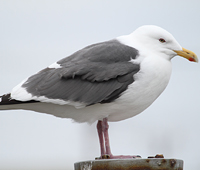 Slaty-backed Gull (schistisagus) adult, March 08 2012, Choshi, Japan. Picture: Peter Adriaens.
Slaty-backed Gull (schistisagus) adult, March 08 2012, Choshi, Japan. Picture: Peter Adriaens. Slaty-backed Gull (schistisagus) adult, March 17 2010, Nemuro, Hokkaido, Japan. Picture: Shiroto.
Slaty-backed Gull (schistisagus) adult, March 17 2010, Nemuro, Hokkaido, Japan. Picture: Shiroto.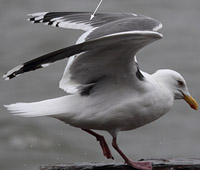 Slaty-backed Gull (schistisagus) adult, March 10 2012, Choshi, Japan. Picture: Peter Adriaens.
Slaty-backed Gull (schistisagus) adult, March 10 2012, Choshi, Japan. Picture: Peter Adriaens.








